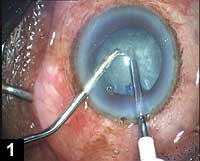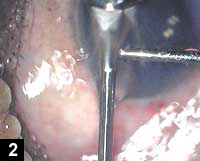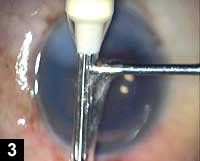Cutting phaco sleeve permits ultrasmall-incision surgery
Using a cut sleeve without irrigation eliminates water splashing and improves visibility during surgery.
CHENNAI, India — Phaco-emulsification needle incision technology — phakonit — pioneered by Amar Agarwal, MD, has advanced the field of cataract surgery through ultrasmall incisions. A phaco needle is usually 0.9 mm in diameter. When it is covered by the sleeve the diameter increases to 2.4 mm and the wound size also increases to 2.4 mm. Phakonit achieves an incision smaller than that required by phacoemulsification by eliminating the sleeve that covers the phaco needle. Thus the wound size in phakonit reduces to 0.9 mm (figure 1).
Disadvantages
| |
| |
|
The silicon sleeve that covers the phaco needle protects the lips of the corneal incision from the heat generated by the phaco needle during emulsification and directs the infusion of fluid from the base of the phaco needle to the anterior chamber. When phaco surgery is performed without the sleeve, we should anticipate two problems.
One problem is wound burns. Two, the fluid coming from the irrigation at the base of the phaco needle is unable to enter the anterior chamber.
During my phakonit surgeries I faced another unique problem of splashing of fluid from the phaco needle outside the incision during emulsification. The fluid in contact with the base of the vibrating phaco needle during emulsification was churned, thus releasing droplets of fluid. These fluid droplets could hamper the surgeon’s view directly or by getting deposited on the microscope objective (figure 2).
Solution
To eliminate wound burns, we should have some way of cooling the corneal entry wound. This is usually taken care by the fluid that leaks out of the eye from the main wound, as the naked phaco needle without the sleeve does not provide a watertight wound. To provide irrigation to the anterior chamber, we use the irrigating chopper through the side port connected to the irrigating bottle, along with an air injector specially devised for this purpose.
To prevent the splashing of fluid during emulsification from the base of the phaco needle, I use the cut sleeve around the base of the phaco needle (figure 3).
We cut the sleeve in such a manner that it covers only the base of the phaco needle and does not enter the eye. Thus we are able to prevent the splashing of fluid during emulsification and at the same time keep the wound size to 0.9 mm.
Reducing wound burns
During phakonit surgery, fluid constantly leaks out of the eye from the main entry wound, as the incision around the phaco needle without the sleeve is not watertight. This fluid comes from the irrigating chopper connected to the air injector. If we connect another fluid irrigating line, the phaco needle with cut sleeve, fluid travels from the base of the phaco needle toward the entry wound from outside. This stream of fluid meets the stream coming from inside eye at the corneal entry wound, causing turbulence and fluid collection in the operating field. This reduces visibility during surgery.
Because the wound is cooled internally by the fluid leaking from the eye outward, there is no need for this second irrigation line. More important, when we connect the second irrigation line to the phaco handpiece with the cut sleeve, the irrigation is always on but we need it only during emulsification. Thus it is better to use an assistant who could drop cooled saline at the external wound only during emulsification.
Air injector
In my opinion, without an air injector (air pump) it is dangerous to perform phakonit, as the inflow into the eye without the air injector is not sufficient to prevent surge. An inflow of at least 90 mL/minute is needed to prevent surge. Measure the inflow through the irrigating chopper and it will always be less than 90 mL/min, whether we use a transurethral resection tubing or we keep the bottle at the rooftop. The only way to overcome this problem is to use an air injector that can provide adequate inflow through the irrigating chopper to prevent surge.
One problem encountered when using an air injector is whenever the air injector is switched off, fluid flows by gravity into the air injector tubing, and when we switch it on the pressure generated by the air injector is insufficient to overcome the inertia of the fluid already present in the tubing. This results in no air being pumped in to the irrigating bottle. This problem can easily be overcome by connecting the air injector to the nondependent portion of the irrigating bottle.
As a corollary, it becomes prudent to use the plastic bottle and to make only one entry with the air injector needle on the nondependent part of the bottle, as more than one entry leads to air leak and inadequate pressure buildup.
Titrating the pressure
It is possible to vary the pressure at which air is injected into the irrigating bottle by using a digital air injector. I use the air injector manufactured by Appasamy Associates, which lets me control the air pressure and hence the fluid that is entering the eye through the irrigating chopper. The instrument has a digital pressure display and a rotary knob for increasing or decreasing the pressure of air injected.
Conclusion
I advocate phakonit with cut sleeve with out irrigation to eliminate water splashing during phakonit to improve visibility during the surgery. An air injector, preferably with an adjustable pressure setting, is essential for eliminating surge during phakonit surgery.
For Your Information:
- D.P. Prakash, FRCS, is chief of ophthalmology, Appasamy Eye Hospital. He can be reached at 23 Friends Ave., Arumbakkam, Chennai-600 106, India; +(91) 44-24755331; e-mail: prakashduddi@yahoo.co.in. Dr. Prakash is an employee of Appasamy Associates and Appasamy Eye Hospital.



